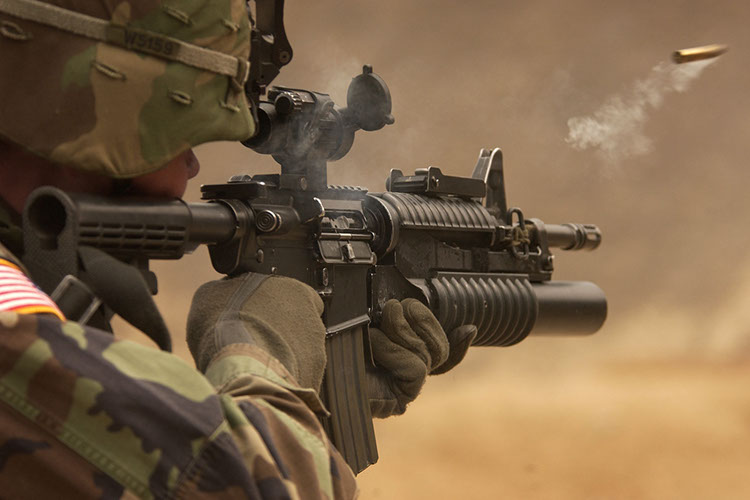
Used in hunting, sport shooting and military applications by nations throughout the world (even non-NATO nations), the .223 Remington round has been used by no fewer than 88 military service rifles and light machine guns in its relatively brief history. Its effectiveness and performance was even replicated by the Russians with their 5.45 x 39 mm variant in the AK-74 and its variants, as well as by the Chinese with their 5.8 x 42 mm with the QBZ-95.
Armalite and other manufacturers began developing what would become the .223 in the 1950’s as part of a new Small Caliber High Velocity (SCHV) program that was tasked with the creation of a round smaller than the then-standard 7.62 x 51 mm NATO. The goal was to create a round that would allow for the implementation of lighter, faster shooting service rifles, without sacrificing too much of the big 7.62 mm round's performance. They used Remington's commercial .222 round as a base point, but it soon proved ineffective as it met neither the velocity nor the penetration requirements downrange.
To address this, ArmaLite tasked Remington with addressing these shortcomings, causing Remington to lengthen the case body and shorten the neck, thus creating the .222 Remington Special. However, around this time Remington had also created the .224 Springfield, which was later sold commercially as the .222 Remington Magnum. So, to avoid certain confusion, Remington renamed the .222 Remington Special, choosing instead to call it the .223 Remington. Regardless of what civilians called it, once this new round was adopted by the American military (and NATO shortly thereafter) in tandem with the equally new M16 rifle, it would come to be known by yet another name: 5.56 x 45 mm, or 5.56 for short.
Meanwhile, Colt had recently acquired the license to produce the ArmaLite AR-15 for the military. Colt quickly recognized the potential of their new rifle and, in 1963, began to sell semi-automatic variants to law-enforcement agencies and civilians. However, these rifles differed from the fully automatic M16s they were producing for the military in one crucial way: they were chambered for the newly distributed commercial Remington .223 cartridge. This began the debate that's been raging ever since: can you fire .223 from a 5.56 chambered rifle or 5.56 from a .223 chambered rifle?
The general rule of thumb for this is: you can safely fire .223 from a 5.56 chambered rifle (with some velocity and accuracy sacrificed); however, following the recommendation put forth by the Sporting Arms and Ammunition Manufacturers' Institute (SAAMI) you should not fire 5.56 from a .223 chambered rifle..
The main reason for this is lies in the leade, which is also called the throat of the rifle, the portion of the barrel directly in front of the chamber where the rifling has been conically removed to allow room for the seated bullet. In a rifle chambered for 5.56, the leade is longer than in a rifle chambered for .223 Remington. According to specifications, a .223 chamber's leade is 0.085”, while the 5.56 NATO chamber’s leade is typically double that amount; 0.162“.
This discrepancy exists because most 5.56 NATO ammunition is loaded to obtain a higher chamber pressure, which gives it greater velocity. This requires slightly more leade in the barrel in order to prevent the pressure spikes that can occur when a bullet engages the rifling too early in the firing process. This is precisely what can happen when 5.56 NATO ammunition is fired in a .223 Remington chamber.
While most sources of information are in consensus on this recommendation, there are some sources who don't agree with that 5.56 ammunition is unsuitable for use in a .223 chambered rifle, as it is listed in SAAMI’s “Unsafe Firearm-Ammunition Combinations.” Some of the opposition comes from reputable subject-matter experts. ArmaLite, for example, claims to have used millions of rounds of NATO ammunition in their ArmaLite SAAMI spec chambers over 24 years, without failure of their rifles.
So, while you may be able to use 5.56 in place of .223, unless you have a rifle chambered in.223 Wylde or Multical (both of which were designed to bridge the gap between 5.56 and .223 Remington), playing it safe might be the better bet. After all, SAAMI’s recommendation wouldn't exist without some merit, so why take unnecessary risks with your prized possession?